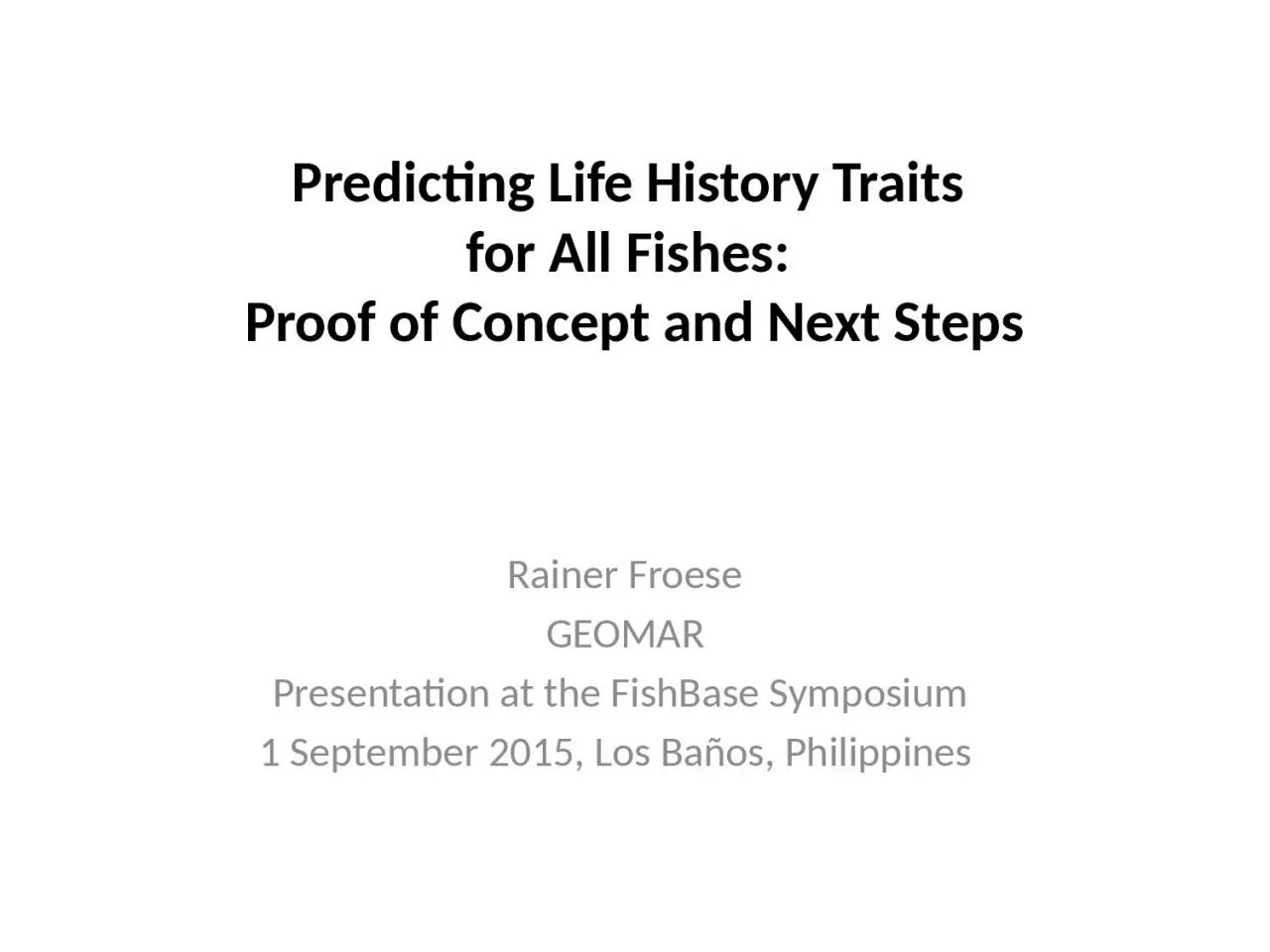

T raits for A ll F ishes Proof of Concept and Next S teps Rainer Froese GEOMAR Presentation at the FishBase Symposium 1 September 2015 Los Baños Philippines FishBase ID: 933130
Download Presentation The PPT/PDF document "Predicting Life H istory" is the property of its rightful owner. Permission is granted to download and print the materials on this web site for personal, non-commercial use only, and to display it on your personal computer provided you do not modify the materials and that you retain all copyright notices contained in the materials. By downloading content from our website, you accept the terms of this agreement.
Slide1
Predicting Life History Traits for All Fishes: Proof of Concept and Next Steps
Rainer Froese
GEOMAR
Presentation at the
FishBase
Symposium
1 September 2015, Los
Baños
, Philippines
Slide2FishBase Data Content
Slide3Predicting LWR for All Fishes
Slide4Bayesian Inference on LWRFishBase contains Phylogeny and body shape for all speciesFor species without published LWR estimates, LWRs of close relatives with same body shape are used for Bayesian predictionsThis results in LWR predictions for all species of fish, with indication of uncertainty Whenever new LWRs are entered, these predictions are updated (confidence limits become narrower)
Slide5FishBase Data Content
Slide6Slide7Slide8Proof of Concept228 LWR published in JAI 31 were compared against Bayesian predictions:69% point estimates fell within predicted range85% were not significantly differentMost of the significantly different LWRs were actually questionable (small number of specimens, narrow length range, inclusion of early juveniles, other problems)
Thanks to Rudy Reyes for compilation of data and provision of example
Slide9Change in Body Shape between Juveniles and Adults
b
= 2.6
Alectis
indica
17 cm
> 1 m
Solution: Estimate separate LWR
f
or juveniles and adults!
Slide10Improving ScienceLWR studies submitted to JAI or ACTA are now routinely compared against predictions in FishBaseSignificantly different LWR estimates are subjected to extra scrutinyFor example, if indeed body shape changes substantially during adult life (b > 3.5 or < 2.5), that should be visible when comparing photos of juveniles and adults
Slide11Bayesian Prediction of GrowthGrowth is essentially described by two parameters, asymptotic length (L∞), and how fast that length is approached (K)Phylogeny, maximum length, body shape, environmental temperature and activity level will be used to predict growth parameters for all species
Slide12Asymptotic length and maximum length are highly correlated
1:1
Slide13Influence of Temperature
Slide14Influence of Habitat or Life Style
Slide15Understanding Growth Space
t
ropical
p
elagiceel-like
bony fishcold water
d
emersal
h
agfish
s
ubtropical
p
elagic
f
usiform
b
ony fish
Slide16Next stepsPublish the “proof of concept” for LWRFinalize and publish Bayesian growthPredict mortalityPredict generation timePredict resilience (intrinsic rate of population growth)
Slide17Big Question?If we know growth for all fish, what “big question” shall be answered:Do bony fish grow faster than sharks?Do freshwater fish grow faster than marine fish?Other big questions????
Slide18Thank You
Slide19AbstractPredicting life history traits for all fishes: proof of concept and next stepsFor 25 years we have compiled in FishBase key life history traits such as maximum size, growth, longevity, mortality, maturity, fecundity, or diet composition. The compilation reflects what is known, such as maximum length for most species, but mortality for only a few hundred species. Users of these data face three questions: 1) If many estimates of a trait are available for a species, which one shall be used or how shall all estimates be summarized? 2) If only one estimate is available, how representative is it? 3) If no estimate is available, what is the best guess? A rigorous statistical procedure to answer these questions is Bayesian inference, which has recently become practical through new software and fast computers. This technique allows the inclusion of related information, such as correlated traits or estimates from close relatives or previous general knowledge about the trait. We have already applied it to length-weight relationships (LWR), where body shape and LWR of close relatives was used to predict LWR for species without estimates. A meta-analysis showed that these predictions were, in most cases, not significantly different from subsequently published LWR estimates. We are now applying the technique to the prediction of growth parameters, based on maximum size, body shape, temperature, activity level, and estimates for close relatives. First results look very promising. Over the next three years, we plan to apply the approach also to maturity and mortality, aiming at the prediction of the intrinsic rate of population increase (= resilience) for all species of fishes.